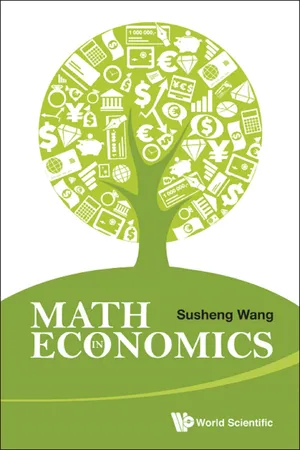
- 272 pages
- English
- ePUB (mobile friendly)
- Available on iOS & Android
Math in Economics
About this book
This textbook concisely covers math knowledge and tools useful for business and economics studies, including matrix analysis, basic math concepts, general optimization, dynamic optimization, and ordinary differential equations. Basic math tools, particularly optimization tools, are essential for students in a business school, especially for students in economics, accounting, finance, management, and marketing. It is a standard practice nowadays that a graduate program in a business school requires a short and intense course in math just before or immediately after the students enter the program. Math in Economics aims to be the main textbook for such a crash course.
The 1st edition was published by People's University Publisher, China. This new edition contains an added chapter on Probability Theory along with changes and improvements throughout.
Request Inspection Copy
This textbook concisely covers math knowledge and tools useful for business and economics studies, including matrix analysis, basic math concepts, general optimization, dynamic optimization, and ordinary differential equations. Basic math tools, particularly optimization tools, are essential for students in a business school, especially for students in economics, accounting, finance, management, and marketing. It is a standard practice nowadays that a graduate program in a business school requires a short and intense course in math just before or immediately after the students enter the program. Math in Economics aims to be the main textbook for such a crash course.
The 1st edition was published by People's University Publisher, China. This new edition contains an added chapter on Probability Theory along with changes and improvements throughout.
Request Inspection Copy
Readership: Students ranging from final undergraduate year, to master's and PhD level in economics, accounting, finance, management, and marketing courses.
Key Features:
- It concisely covers main math knowledge and tools useful for business and economics studies, which includes matrix analysis, basic math concepts, general optimization, dynamic optimization, ordinary differential equations, and probability theory
- Basic math tools, particularly optimization tools, are essential for students in business schools, and especially for students in economics, accounting, finance, management, and marketing
Frequently asked questions
- Essential is ideal for learners and professionals who enjoy exploring a wide range of subjects. Access the Essential Library with 800,000+ trusted titles and best-sellers across business, personal growth, and the humanities. Includes unlimited reading time and Standard Read Aloud voice.
- Complete: Perfect for advanced learners and researchers needing full, unrestricted access. Unlock 1.4M+ books across hundreds of subjects, including academic and specialized titles. The Complete Plan also includes advanced features like Premium Read Aloud and Research Assistant.
Please note we cannot support devices running on iOS 13 and Android 7 or earlier. Learn more about using the app.
Information
1. Vector





Table of contents
- Cover Page
- Title
- Copyright
- Contents
- Preface
- Chapter 1. Linear Algebra
- Chapter 2. Basic Real Analysis
- Chapter 3. General Optimization
- Chapter 4. Dynamic Optimization
- Chapter 5. Ordinary Differential Equations
- Chapter 6. Difference Equations
- Chapter 7. Probability Theory
- References
- Index